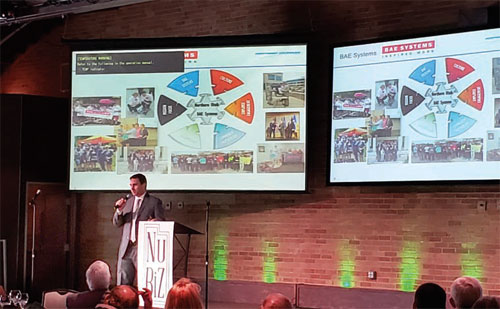By Brice Wallace
While Utah’s economy is booming, Northern Utah’s is lagging, but that should change in the future, according to speakers at a recent economic outlook gathering.
Brandon Fugal, chairman of Colliers International in Utah, said Davis and Weber counties could benefit economically as an alternative to the exploding Silicon Slopes area.{mprestriction ids="1,3"} Natalie Gochnour, director of the University of Utah’s Kem C. Gardner Policy Institute and chief economist for the Salt Lake Chamber, said Northern Utah counties should be working together, including formulating a better message. And Gordie Russell, regional senior vice president at Northrop Grumman, said the area is primed for lots of employment growth in the aerospace sector.
All three spoke in Ogden at the Bank of Utah’s annual Economic Forecast event, which was presented along with the Ogden-Weber Chamber and the Weber State University Goddard School of Business and Economics.
“I think Davis/Weber county is ripe for regional and national site selectors from both a recruitment standing, but also you have a robust environment for economic development and growth to come into the future,” Fugal said.
Currently, construction projects are concentrated in Utah County, led by Lehi and Pleasant Grove.
Davis County is “unfortunately lagging,” Fugal said, “but I think there’s opportunity in the future to see new redevelopment come into place and really position this market against the other counties.”
Record-low unemployment is among the factors that could shift activity from the tech-heavy Silicon Slopes area — southern Salt Lake County and northern Utah County — to Northern Utah, he said.
“The problem is those companies are all cannibalizing each other for the same employees, and they’re driving wage rates up and it’s very difficult. You contrast that with Davis/Weber county. I think Davis/Weber county, not only being a college town but also having, I think, a much more healthy environment to recruit and retain talent from, is well-positioned to really provide an alternative for growth and economic development and still offer an unmatched Utah address with this incredible quality of life and backdrop that we all really benefit from.”
Nearly 2 million square feet of construction is underway in Utah County, while in the Davis/Weber area, the figure is 280,000 square feet. “I predict that will change in the future,” Fugal said. “You’re in a good spot for future growth and development.”
Gochnour noted that a lot of Utah’s population growth is happening in “ring” counties surrounding the Wasatch Front. In Weber County, the growth rate is only 1.1 percent. “I would say that in that measure, Weber County is underperforming,” she said. “I think with some of the things I’ve seen and some of the things being shared today, I would expect that to change.”
While Utah County “is carrying the Utah economy” with a 5 percent job growth rate — Utah’s overall is 3.1 percent — the Davis/Weber area has the ingredients to thrive, she said.
“I am very optimistic about things happening here because you have land, you have location and you have leadership,” she said, noting that Utah’s legislative chambers are led by Senate President Stuart Adams of Layton and House Speaker Brad Wilson of Kaysville.
During a question-and-answer session, Gochnour urged Northern Utah counties to work together in order to strengthen the area’s economy.
“I think that this area needs to collaborate in a very strong way with your adjoining counties, whether it be Davis or Box Elder or Morgan or Cache,” she said. “Nobody cares about county boundaries, meaning the economy doesn’t care, industry doesn’t care. I think it’s really weird for Davis County to have an economic development plan and Weber County to have an economic development plan. That’s not how markets work. So, I would say, ‘Share the stage.’”
The area also needs to develop “a better story and an economic brand,” she said, suggesting that the area’s ability to “build things” is an option. The area’s railroad heritage and strong manufacturing sector are examples she cited.
“I think somehow Northern Utah needs to put a better message around who you are and what you want to become in the future,” Gochnour said. “Because of your location, because of your land, because of your leadership, because of your economic assets, you should be doing better on some of those growth things, and I do think that that’s likely to happen.”
While other parts of the state are getting attention as economic powerhouses, “if you lift up the rocks and consider what’s here,” she said, “it’s extraordinary.”
Among the real estate gems benefiting Northern Utah are Station Park in Farmington and the Falcon Hill development on the edge of Hill Air Force Base, Fugal said. Station Park’s 1 million square feet is 100 percent occupied, making the mixed-use project “truly a landmark along the Wasatch Front, if not the Mountain West,” he said. Meanwhile, the 500-acre Falcon Hill office park project “will continue to transform this market area and bring in jobs and other opportunity,” as it builds out to upwards of 2 million square feet of development, he added.
“And it’s not just aerospace and composites,” Fugal said. “I predict you’ll see technology firms and other industry gravitate toward the area because of its proximity to the freeway, services and employment.”
Russell noted that Boeing, BAE Systems and Northrop Grumman are among aerospace companies in Northern Utah that are hiring lots of workers. The area has more than 30 such companies and the majority of the sector’s 30,000 workers in the state. Northrop’s flight systems division hired more than 2,400 employees in 2017 and over 2,000 last year. It has nearly 5,800 workers now but needs to hire more than 5,000 over the next one or two decades in order to address attrition and the company’s growth goals, he said.{/mprestriction}








